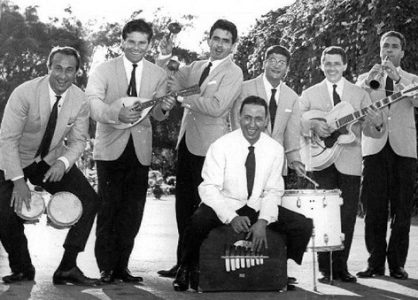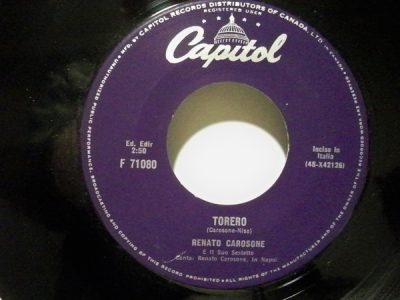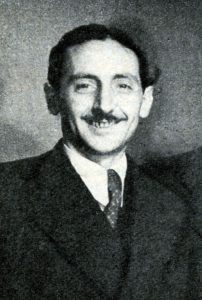#59: Torero by Renato Carosone
City: Ottawa, ON
Radio Station: CKOY
Peak Month: July 1958
Peak Position in Ottawa ~ #2
Peak position in Vancouver ~ #29
Peak Position on Billboard Hot 100 ~ #18
YouTube: “Torero”
Lyrics: “Torero”
Renato Carosone was born in Naples in the Kingdom of Italy in 1920. At 14, he wrote “Triki-trak”, his first composition for piano, and in 1935, he was hired by an opera dei pupi puppet theater to play music to the battles of Count Roland and Renaud. Subsequently, he worked at E.A. Mario’s publishing house teaching new songs to singers. He studied piano and composition at the Naples Conservatory under , and obtained his diploma in 1937, when he was just 17. A few months later he signed a contract with comedian Aldo Russo to perform as a band leader in Italian East Africa. The troup landed in Massawa, Eritrea, to work in a restaurant-theatre frequented by Italian workers. He remained after a short stay with Aldo Russo, and met a woman and got married.
With the outbreak of World War II, Renato was conscripted to serve in Italian Somaliland on the Indian Ocean coastline. After the Italians surrendered to Allied Forces in November 1941, Carasone became the musical director of the Odeon theater and the adjoining nightclub in Asmara in present-day Eritrea. He was a prominent figure of the local music scene, performing a combination of big-band music, Neapolitan songs and Eritrean percussive elements. After WWII, in 1946 he moved with his wife and son to Brindisi in the heel of the ‘Italian boot’ in southern Italy. He continued to find clubs to perform in with his band and his popularity soared.
In 1954, Renato Carosone’s single “…E la barca tornò sola” ranked in the Top 100 year end hit on the Italian pop chart.
In 1955, Renato Carosone had the #3 hit of the year titled “La Pansè”, while “La Donna riccia” ranked at #7 for the year. His cover of “Johnny Guitar” landed at #14 for the year, with “Rapsodia svedese (Swedish rhapsody)” at #25 and “Scapricciatiello” at #30, “Malafemenna” at #39, “Ufemia” at #59, and “Ciribiribin”, “Tani”, “‘Stu fungo cinese” and finally “Eh cumpari”, – the last of these his eleventh single to rank in the Top 100 for the year 1955.
In 1956, Renato Carosone had the number-one song of the year in Italy with “Maruzzella”. Another number-one hit for Carosone was “Io, mammeta e tu” which ranked at #4 for the year 1956; And “Giuvanne cu ‘a chitarra” wound up at #7 for the year, with “‘O Russo e ‘a rossa” at #12, and “Guaglioni” at #25 for the year, “Domani” at #27, “Vino Vino” at #28, “Mambo Italiano” at #33, while “T’è piaciuta” was his ninth song that made the Top 100 year-end hits on the Italian pop chart in 1956.
In 1957 Carosone and his band embarked on an American tour, kicking off in Cuba. This tour concluded with a triumphant performance at the prestigious Carnegie Hall in Manhattan.

Renato Carosone and his sextet (Renato Carosone E Il Suo Sestetto)
Carosone was then signed by Capitol Records, which released his debut albums: Honeymoon in Rome in 1957.
In 1957, Renato Carosone had the #9 hit of the year in Italy titled “Chella llà”. As well, the #11 hit of 1957 in Italy was Carosone’s “Tu vuo’ fa’ l’americano”, the #15 hit of the year “Lazzarella”; The #18 hit of 1957 with “Serenatella sciue’ sciue'”; And “Torero” was the #21 song of the year in Italy in 1957, and a number-one hit. In addition, “Piccolissima serenata” ranked at #26 for the year 1957 in Italy, and “Storta va deritta vene”, ranked at #39 for the year; And “‘O Suspiro” reached #41 for the year 1957 in Italy. Wrapping up the year, Renato Carosone had two more singles that ranked in the Top 100 for 1957 in Italy: “L’hai voluto te” and “‘A Casciaforte”.
In 1958, Carosone’s “Torero” began to chart on Top 40 radio in Canada, the USA and the UK.

Renato Carosone sings “Torero” in both Italian and Spanish throughout the song. In addition to Carosone, the song was composed by Nisa the pen name of Nicola Salerno. Born in Naples in 1910, Nicola Salerno came to prominence in 1947 with his recording of “Eulalia Torricelli”, a song about an unhappy love affair between a wealthy girl from northern Italy and a guy named Giosuè. In 1955, Salerno began to work with Carosone and they proved to be a potent songwriting team. In 1956, “Guaglioni” won the Song of the Year award at the Naples Song Festival (but for a recording of the song by actor and singer Aurelio Fierro). In 1964, Nisa’s song “Non ho l’età” was recorded by Gigliola Cinquetti. It won the Eurovision Song Contest in Copenhagen in March 1964 and the Sanremo Music Festival (February 1964). “Non ho l’età” topped the pop charts in Belgium, France and Italy, and was a Top 5 hit in Argentina, Finland, Hong Kong, the Netherlands, Norway, and West Germany. In addition, Nicola Salerno was a successful illustrator. During the 1920s and 1930s he created cover designs for scores of Neapolitan music.

Nicola Salerno
Beginning in 1932, Nicola Salerno’s compositions were recorded by Carlo Cestari, Dino Oliveri, Emílio Livi, Daniele Serra, Carlo Butti, Mario Latilla, Myriam Ferretti, and others. Nicola Salerno died at the age of 59 in 1969. His son, Alberto Salerno, went on to become a lyricist.
Both torero and toreador and synonyms for bullfighter. A bullfighter is someone who enters a bullfighting ring to square off with a bull. He is called toureiro in Portuguese. Another name for a bullfighter is matador, literally ‘killer of bulls.’ Bullfighting, historically, started more with nobles upon horseback, all lancing bulls with accompanying commoners on foot doing helper jobs. As time went by, the work of the commoners on foot gained in importance up to the point whereupon they became the main and only act. Bullfighting on horseback became a separate and distinct act called “rejoneo” which is occasionally still performed. although less often.
The English translation of the first verse of “Torero” introduce the young lad who imagines he’ll be a toreador.
You lose sleep to read these comic books,
and your mother threatens you,
and your father gets mad…
These comics are doing your head in,
when you look into the mirror,
you want to be a “toreador”!
As they do in Santa Fé,
as they do in Hollywood.
And with this excuse, oh boy!,
you are not studying anymore.
“Torero” peaked at #1 in Buffalo, #2 in Ottawa, #3 in Schenectady (NY), Torrington (CT), Washington DC, and Boston, #4 in New York City, Worcester (MA), #6 in Pittsburgh, #8 in Lowell (MA), #10 in Los Angeles, and Springfield (MA), and #12 in Toronto. In the USA, “Torero” peaked at #18 and #25 in the UK.
“Torero” was translated into twelve languages and covered by almost thirty artists in America alone, including versions by The Andrews Sisters and Connie Francis. Later in 1958, Carosone released the album Blue Italian Skies. In 1959 he released the album Renato Carosone!. His fourth studio album, Carnevale Carosone was released in 1960.
For the year of 1958, Renato Carosone had the #17 hit of the year in Italy: “Caravan Petrol” (also written by Nissa – aka Nicola Solerno), the #39 hit of the year in Italy: “A Sunnambula (Carmela è una bambola)”, at #70 in Italy in 1958 was Carosone’s version of “Colonel Boggy March (Theme From the River Kwai)”, and the #82 year-end hit was Renato Carosone’s fourth Top 100 year-end hit in 1958: “‘O Sarracino”. However, in 1959, Carosone only managed one modest hit single “Cow-Boy” to crack the Top 100 year-end hits on the Italian pop chart.
By 1960, Renato Carosone was elbowed out of the Top Ten on the pop charts by Italian recording artists Rita Pavone, Caterina Valente, Edoardo Vianello, Adriano Celantano, Nico Fidenco, Peppino Di Capri, Tony Dallara, Pino Donaggio, Joe Damiano, Umberto Bindi, Dalida, Mina, Gino Paoli, and others. As well, English language pop stars were crowding the Italian pop charts. Among the most successful on the Italian pop charts were Elvis Presley, Paul Anka, Frankie Avalon, Dean Martin, Chubby Checker, Bobby Darin, Neil Sedaka, and Connie Francis. Other European artists like Edith Piaf, Petula Clark, Charles Aznavour, and Cliff Richard were also consistent favorites on the Italian pop charts in the early sixties.
At the height of his career, Carosone announced his retirement from music in 1960. He felt that the advent of rock and roll had the consequence of making his swing, big-band sound no longer popular: “I’d rather retire now on the crest of the wave, than being tormented later by the idea of rock and roll wiping away all that I have achieved in so many years of hard work”. His decision to retire caused an uproar. Some observers even suspected obscure underworld threats. Away from the spotlight, Carosone turned to other interests, mainly painting. In 2007 the Castel Sant’Angelo Museum in Rome organized a large exhibition of his work.
On August 9, 1975, Carosone made his comeback in a televised concert. That year he released his fifth studio album titled Pianofortissimamente Carosone and also Carosone ’75 which included his cover of Bill Haley and His Comets’ “Rock Around The Clock”. He then resumed his musical career with live concerts, performances at the Sanremo Music Festival and TV appearances until the late 1990s. In the 1980s, he released his final two studio albums Sempre and Nu’ canzoncella doce doce.
Renato Carosone died at the age of 81 in May 2001.
October 10, 2025
Ray McGinnis
References:
“Top Annuale Singloli 1955,” hitparadeitalia.it.
“Revolutionary Italian singer Renato Carosone dies at 81,” Associated Press, May 22, 2001.
Aurelio Fierro, “Guaglioni“, Durium Records, 1956.
Renato Carosone, “La Pansè“, Pathé Records, 1955.
Renato Carosone, “Maruzzella“, Pathé Records, 1956.
Renato Carosone, “Lazzarella“, Pathé Records, 1957.
Artis Info, “Nicola Salerno,” music.metason.net.

CKOY 1310-AM Ottawa Top Ten | July 19, 1958

Fascinating story. I was surprised this made it to #18 on the Billboard Hot 100 in 1958 and #12 on Toronto’s CHUM chart. I have never heard it before or at least don’t remember hearing it. Definitely not my cup of tea.